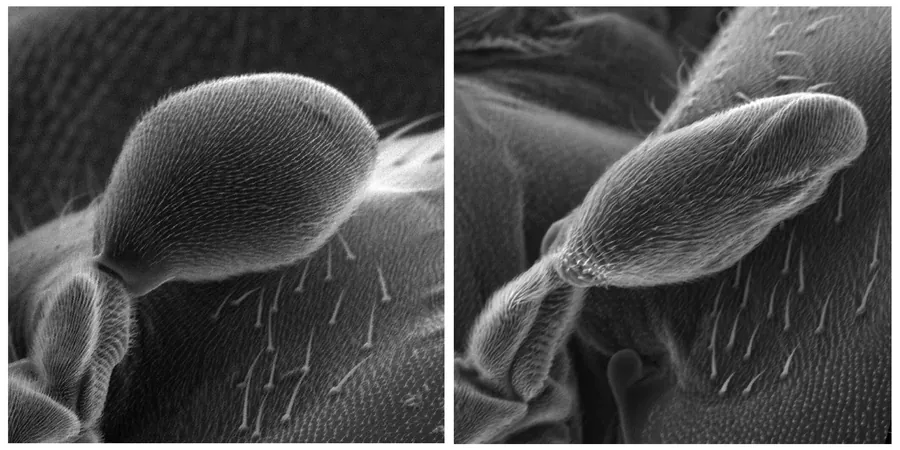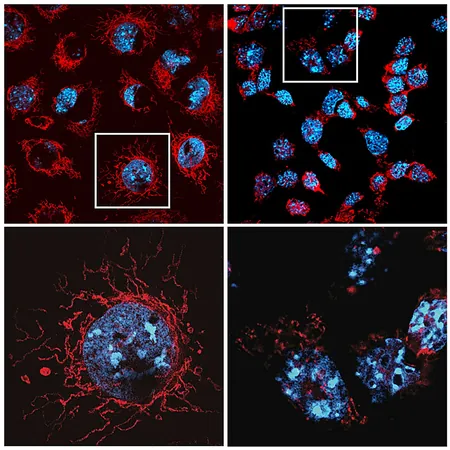
Unlocking the Secrets of Fly Flight: How Their Gyroscopes Are Crafted!
2025-06-12
Author: Ming
Revolutionary Research Unveils Fly Flight Mechanics!
A groundbreaking study from the Institute for Neurosciences (IN) in Spain has shed light on the mysterious formation of halteres, the tiny yet vital organs that allow flies to soar gracefully through the air. These remarkable appendages, located just behind the main wings, act as biological gyroscopes, stabilizing the insect during flight.
Led by the brilliant mind of researcher José Carlos Pastor Pareja, the team’s findings were published in the prestigious journal Current Biology. Their research reveals a surprising twist: contrary to what scientists once believed, halteres are not hollow but possess an intricate internal structure.
A Ingenious Design: Nature’s Own Support System!
Pastor Pareja elaborates, "Think of the haltere's structure as nature's very own architectural support. Without its internal connections—much like a tent without guy ropes—the haltere would become elongated and lose its shape, rendering it ineffective for flight."
The study dives deep into metamorphosis—the fascinating transformation of larvae into adult flies. It shows how both wings and halteres originate from a delicate layer of cells. In a twist, the researchers found that a collagen-rich extracellular matrix must first break down for cellular projections to emerge and strengthen the haltere.
The Mechanics of Flight: A Dance of Tension!
These cellular connections act as biological tensors—resisting the forces that could otherwise distort the haltere. In experiments with genetically modified fruit flies, the team observed that without these connections, the haltere lost its critical rounded shape.
Interestingly, the haltere is constantly under tension: one force pulls at its base, while another anchors it firmly to the insect's outer cuticle. It is this sophisticated internal support system that ensures the haltere retains its essential geometry.
How They Made the Discovery: Cutting Edge Techniques!
Using advanced electron microscopy and live imaging techniques during the fly’s metamorphosis, the researchers captured the dynamic changes occurring in real-time. Pastor Pareja notes, "We witnessed how these cellular projections actively stabilize the haltere, countering any forces that could deform it. Our findings highlight the critical role these supports play in the organ’s function."
Implications Beyond Flight: Insights into Developmental Biology!
This study offers pivotal insights not just into the lives of fruit flies, but into the broader question of how various organs shape themselves in animals. These revelations might even inspire innovations in tissue engineering and the development of biomimetic structures.
Collaboratively conducted alongside experts from Tsinghua University in China and the Severo Ochoa Molecular Biology Center, this research exemplifies the power of interdisciplinary collaboration in unlocking nature's secrets.



 Brasil (PT)
Brasil (PT)
 Canada (EN)
Canada (EN)
 Chile (ES)
Chile (ES)
 Česko (CS)
Česko (CS)
 대한민국 (KO)
대한민국 (KO)
 España (ES)
España (ES)
 France (FR)
France (FR)
 Hong Kong (EN)
Hong Kong (EN)
 Italia (IT)
Italia (IT)
 日本 (JA)
日本 (JA)
 Magyarország (HU)
Magyarország (HU)
 Norge (NO)
Norge (NO)
 Polska (PL)
Polska (PL)
 Schweiz (DE)
Schweiz (DE)
 Singapore (EN)
Singapore (EN)
 Sverige (SV)
Sverige (SV)
 Suomi (FI)
Suomi (FI)
 Türkiye (TR)
Türkiye (TR)
 الإمارات العربية المتحدة (AR)
الإمارات العربية المتحدة (AR)